Cocktail garnish
Cocktail garnishes are decorative ornaments that add character or style to a mixed drink, most notably to cocktails.[1]
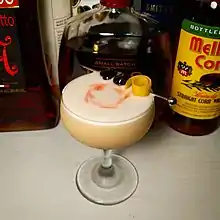
They are used to complement and enhance the flavors in a drink by stimulating the special nerve cells in the nose and mouth[2]
A large variety of cocktail garnishes are used. Many rum-based cocktails, especially those with fruit flavors, tend to be decorated with tropical-themed garnishes or slices of fruit. Tequila-based drinks favor limes and other citrus fruits. Gin- and vodka-based drinks tend toward garnishes with a more dignified flair (olives, onions, or possibly a citrus twist or a single maraschino cherry), unless they are variations of a fruity rum-based drink. Whiskey- and brandy-based drinks tend toward minimal garnishment, if any. Restaurant chains and hotel bars tend to use larger and more ostentatious garnishes, and neighborhood bars tend to go the other extreme.
Some garnishes are essential to completing the recipe, as in the case of the olive in the Martini, or the cherry in the Manhattan, or the onion in the Gibson. Another reason for garnishes is to make cocktails more "camera ready" so that when photos are taken for the press or social media, different drinks will not look so much alike.[3]
Common edible garnishes
Among common edible garnishes are the following:[4][5]
- Candied ginger[3]
- Carrot sticks
- Celery stalks (usually with leaves attached)
- Cherries
- Cinnamon, grated
- Cocktail olives (often stuffed with pimentos)
- Cocktail onions
- Flowers
- Lemon slice, twist, or wedge
- Lime slice, twist, or wedge
- Mint sprigs or leaves
- Nutmeg, grated
- Orange slice, twist, or wedge
- Pineapple slice or wedge
- Pepper
- Salt, coarse (applied to the rim of glasses)
- Star anise[3]
- Sugar, granulated or powdered
- Shrimp
- Strawberries
- Watermelon wedge
- Bitters dashed onto the egg-white foam atop a shaken cocktail such as a whiskey sour.
Common inedible garnishes
These garnishes are purely for decoration or dramatic flair.[6]
- Plastic animals (attached to the rim of the glass)
- Bead necklaces (especially common during Mardi Gras and Carnival)
- Candles
- Cocktail umbrellas
- Drinking straws (colorful or unusually shaped)
- Fire (see Flaming beverage)
- Flags
- Plastic swords
- Sparklers
- Swizzle sticks
- Inedible flowers
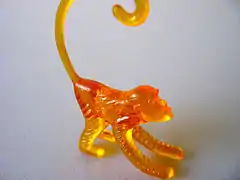 Cocktail monkey
Cocktail monkey
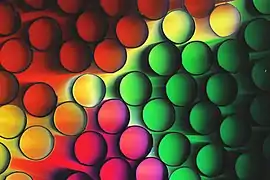


 Swizzle stick and straw
Swizzle stick and straw
See also
References
- Dale DeGroff (2010). The Craft of the Cocktail: Everything You Need to Know to Be a Master Bartender, with 500 Recipes. Potter/TenSpeed/Harmony. ISBN 9780307762276. Retrieved 29 March 2016.
- Navarro, V., LA Speakeasy, 02/27/2018
- https://punchdrink.com/articles/cocktail-garnishes-evolution-history-tiki-garnish/
- Shawn Soole & Nate Caudle (2013). Cocktail Culture: Recipes & Techniques from Behind the Bar. TouchWood Editions. pp. 23–26. ISBN 9781927129944. Retrieved 29 March 2016.
- Tulula, Philippe (2016-02-25). The Cocktail Garnish Manual: The Complete Guide to Cocktail Garnishes, from Simple to Extraordinary. World Cocktails Publishing. ISBN 9780692507001.
- Rex Bookstore, Inc. (2007). Learning & Living in the 21st Century Iv for H.s.' 2007 Ed. Rex Bookstore, Inc. pp. 333–335. ISBN 9789712347870. Retrieved 29 March 2016.
External links
 Bartending at Wikibooks
Bartending at Wikibooks Media related to Cocktail garnishes at Wikimedia Commons
Media related to Cocktail garnishes at Wikimedia Commons



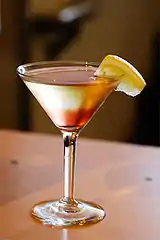


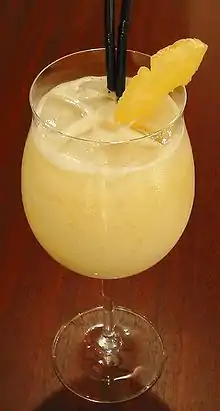
.jpg.webp)


